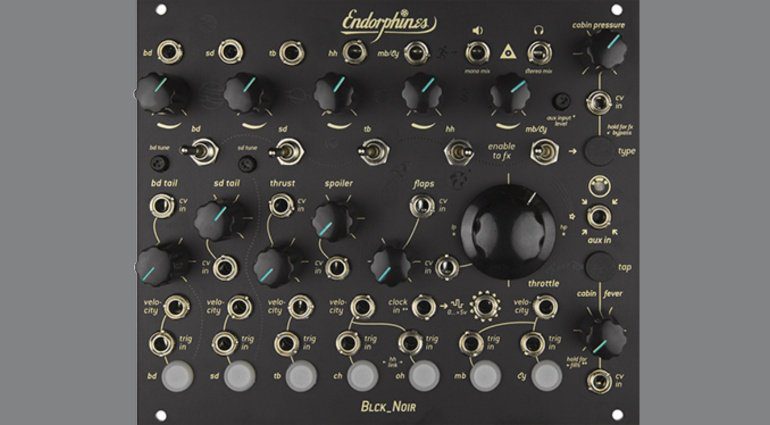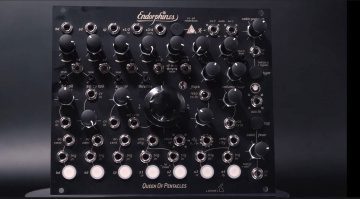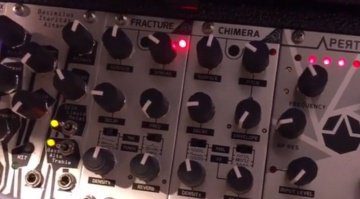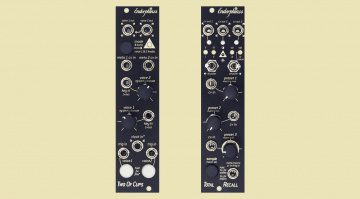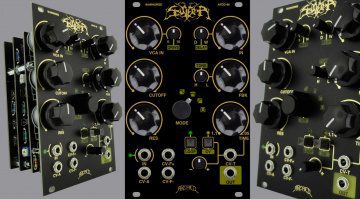Endorphin.es Analog-Drums CR-78 in einem Eurorack-Modul Blck Noir
Endorphines sind bekannt für ihr New-School-Modular mit Buchla-Orientierung. Deshalb überrascht das schwarze analoge Drummodul Endorphin.es Blck Noir um so mehr …
Huch, das ist ja ganz was anderes. Irgendein neues besonderes Modul mit FM oder so hätte man irgendwann mal erwartet, aber: Jetzt gibt es was schön analoges mit dem typischen Vintage-Klatsch und Punch, aber auch der Anmutung der Siebziger (genauer gesagt mehr Rhythm Ace und CR-78 als der TR-Ära). Das alles ist in einem Modul zusammen gefasst.
Endorphin.es Blck Noir – Vintage-Klatsch mit Konsequenz
Das ist auch konsequenter als andere Hersteller das tun. Denn Drums in einem Modul zu bringen ist immer irgendwie „nicht richtig modular“, weil die Synthese gar nicht offen sein kann. Das ist auch generell okay, denn man möchte vielleicht einfach die Drums zusammen mit anderen Sounds komplett im Eurorack installieren und hat Sound und Kontrolle dann komplett dort. Blck Noir heißt das Modul, und es ist ein bisschen versteckt. Aber eigentlich handelt es sich um eine Art CR-78 mit allen Einstellungen, die diese auch hat.
Das alles ist hier auch so, zudem ist es aber doch einfach gehalten. Man hat primär die Lautstärken und ein Filter, und vorallem gibt es einen Eingang für die Anschlagdynamik und damit die Betonung der Quasi-7 Instrumente. Ein paar kryptischere Knöpfe wie Spoiler und Flaps als Buchse gibt es auch. Aber natürlich bezieht sich das und der Tail-Parameter auf die Sounds (Snare-Ausklang), und jeweils kleine Tuning-Potiachsen findet man dann auch. Man kann ein bisschen was ändern, aber nicht 5 Parameter pro Sound. Dennoch hat man ein Schlagzeug zusammen und ein bisschen „Magic“ durch Dynamik, und ein paar Einsteller sind auch vorhanden. Alles natürlich Flugzeug-Sprache, wie bisher haben sie beibehalten, weshalb man schonmal nachfragen muss. Notfalls guckt man aber einfach das Demovideo:
Das Modul ist 7-Stimmig, die Hi-Hats stoppen sich natürlich gegenseitig – man halt also 8 Instrumente.
Infos
- Es gibt mehr dazu auf der Endorphines Facebook Seite, denn die Website enthält wenig an „Informationen“, sie ist eher Magick wie 2 Einhörner.
Video
Sie sehen gerade einen Platzhalterinhalt von YouTube. Um auf den eigentlichen Inhalt zuzugreifen, klicken Sie auf die Schaltfläche unten. Bitte beachten Sie, dass dabei Daten an Drittanbieter weitergegeben werden.
Marker-Infos zum Video
Es gibt einige Marker, die ich wegen der Übersicht direkt hier einfach mal übernehme zur Orientierung, ohne die Site zu verlassen – Copy & Paste:
- 00:00 Welcome, hello and patch previews of what’s to come in the video
- 01:32 Features and functions run down
- 03:13 Beat interjection 1 – various beats with no talking
- 03:32 Individual sounds and controls. Going through the sound of the bass drum, snare, tambourine, hi hats, metallic beat and cymbal. What they are, what control with have over them and what they sound like.
- 06:49 Beat interjection 2 – various beats with no talking
- 07:05 Velocity inputs – using sequences to modulate velocity and also an LFO to fade parts in and out
- 08:13 Making a beat – rather than bringing in a beat already made (Blue Peter style „here’s one I made earlier“) I make a beat live so you can see the connections and how to build a beat from nothing. This includes triggering the sounds as well as modulating the sound parameters.
- 10:27 Beat interjection 3 – various beats with no talking
- 10:48 Throttle – the filter and Flaps – the resonance. Looking at the filter with the internal drums and also using the external aux input to bring in an oscillator to demo the filter too.
- 12:51 Aux input – mixing in synth riffs with the drums for mixing and filtering.
- 13:33 Beat interjection 4 – various beats with no talking
- 13:59 Using the individual outputs to remove sounds from the mix, processing them externally and then using the aux input to bring the processed sounds into the mix. I choose to distort and bit crush the kick for some filthy low end!
- 15:15 The drum buttons – using them for fills, finger drumming and muting the sounds. This also goes through the clock input and it’s use for create the patterns for the drum fills.
- 16:42 Onboard sample and hold. I use it to modulate the noise bit crush on the ’spoiler‘ control. You could patch this into other modules or any parameter on the module.
- 18:29 Beat interjection 5 – various beats with no talking
- 18:50 The 8 on board FX. Including various reverbs, ping pong delay, tape delay and a great freezer. I look at these in more detail in the Grand Terminal video here – https://youtu.be/AogaP8KSaEc . I go through the switching to route sounds into the FX here too.
- 23:20 Beat interjection 6 – various beats with no talking
- 23:46 Using the type button (held) to route all sounds to the FX rather than using the switches which is a nice performance trick. The manual has other things not featured in the video such as using CV to scan through and address the FX themselves and more.

